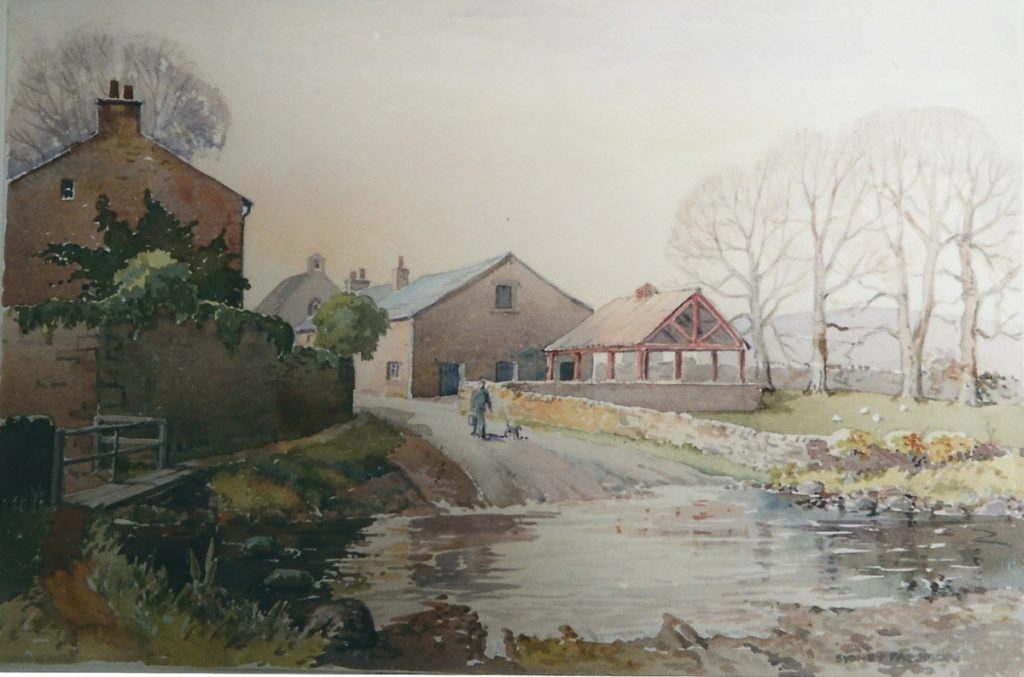Our land, which together with the farm was rented from the Society of Friends (the Quakers), ran down to the little stream called Scotforth Beck, which we knew simply as ‘the beck’, from which it was separated by a wall; further on, on the other side of the beck, there was quite a lot more land, extending on the south side of the road right to the top of the hill. You could walk through these fields to Bailrigg, where the University now is – there was a public footpath, which started just beyond the watersplash and came out at the top of Bailrigg Lane, close to the entrance to Bailrigg House, the home of the Storey family. Further downstream, where it went under the main road, this stream was called Burrow Beck, presumably because in that part of its journey it went past the hamlet of Burrow and the low hill known as Burrow Heights, before flowing into the lake at Ashton Hall. Back upstream, in the Barton Lane area, this stream fed Scotforth Mill, even then long disused as a working mill17 (and now long since demolished), and then it passed almost unnoticed between the fields on either side until it arrived without any fuss at Hala Road.

At this point the road crossed the stream at a ford, which was always a source of interest to us children. This was water you could get at and play with quite safely! For traffic heading in either direction the steep hill beyond this ford was quite a serious obstacle, for horse-drawn vehicles in particular; those who had the option of taking an alternative less hilly route I am sure would have done so, but such traffic as came this way had no option but to go through the water. Pedestrians wanting to cross the beck, on the other hand, were able to keep their feet dry by using the footbridge on the downstream side, which was approached from either side via a raised causeway which gave an elevated view of the water.
We used to ride over this little footbridge on our bikes; it was so narrow that we thought this was quite daring – but then there were those clever kids who could do this without even using their hands! In later days my nephew and his friends used to come down Hala Hill at speed over the rough stony surface and into the water, trying to reach the other side without using the pedals; the width was such that they never made it! Of course, there was not so much traffic even in those days – the road was not tarmacked then – and in our time what little there was was horse-drawn, so there really was not much traffic to look out for. From the bank there were sometimes shoals of minnows to be seen, and we would try to catch them. We’d have had more success if we’d had a net! At the edge of the water there were several quite large boulders, which we would sit on, if it was hot, with our feet dangling in the water to keep ourselves cool.
Sometimes, after prolonged rain, the stream would turn into a roaring torrent. On one particular occasion, when I was quite small, probably about three, I slipped into this torrent from the footbridge and was swept down underneath; I can remember feeling quite happy floating downstream, surveying the scene as it passed by, totally unaware that I was in any danger of ending up drowned. Fortunately, I was saved from this watery fate by our neighbour Maggie Sturzaker: seeing my plight, she and the others rushed through the gate into the field and alongside the beck and, when I eventually drifted to the side, she pulled me out. My sister took me home dripping wet for a change of clothes. Auntie Polly then took charge but, although Dad saw me arriving home in my bedraggled state, I don’t believe she ever told him the full story and what a close shave it had been for me. Maggie18 was a few years older than me and lived with her family at the pottery, just across the beck from our farm.
__________
17 St Bernadette’s RC church and school now occupy the site.
18 Maggie was aged 10 at the time of the 1911 census, so about 5 years older than Eve. She was the 6th of 9 children of James and Sarah Sturzaker of The Old Pottery, Scotforth. James was not a potter, but a milk dealer.
Cross over to The Pottery.
or, return to Memories of Hala Road, Scotforth